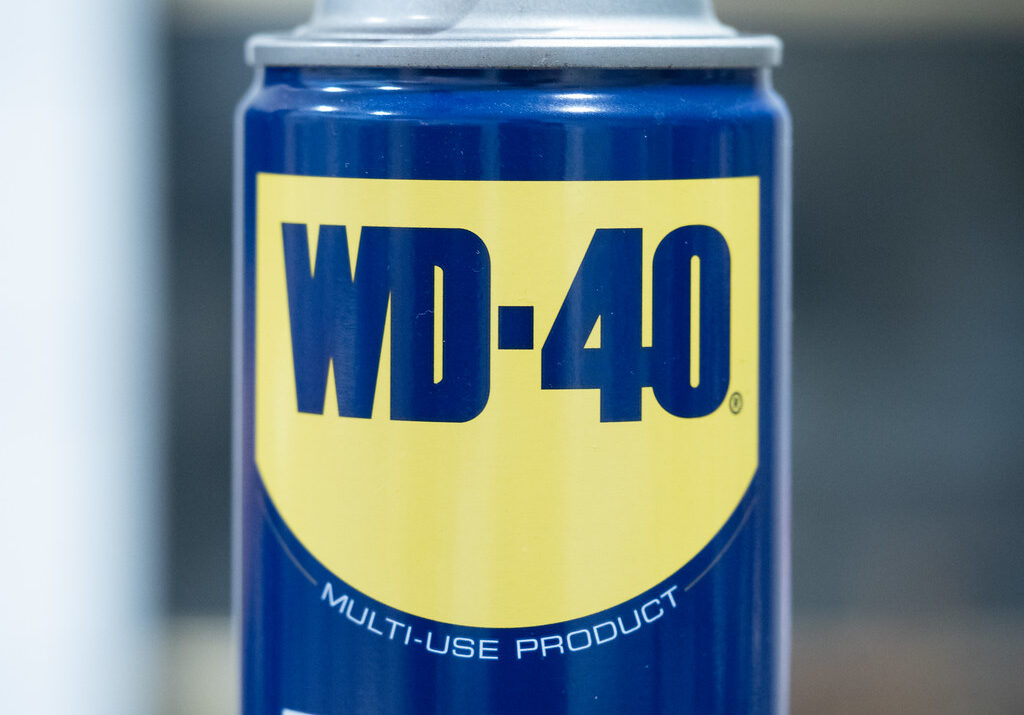
Stains can be a frustrating and persistent problem, whether they appear on clothing, carpets, furniture, or even car interiors. Finding an effective solution to remove these stubborn marks without damaging the surface can be challenging. WD-40, a versatile household product known for its lubrication and water-displacement properties, also excels at removing various types of stains. This article explores how to use WD-40 to tackle different kinds of stubborn stains, ensuring your belongings remain clean and well-maintained.
Contents
Understanding WD-40
What is WD-40?
WD-40, which stands for “Water Displacement, 40th formula,” was created in 1953 by the Rocket Chemical Company. Originally designed to prevent rust and corrosion in aerospace applications, it has since become a go-to solution for numerous household tasks, including stain removal. Its unique composition of hydrocarbons and mineral oil makes it effective at breaking down and dissolving many types of stains.
Key Properties
- Penetration: WD-40 can penetrate crevices and tight spaces to reach and dissolve stains.
- Lubrication: It reduces friction, which can help in loosening and removing sticky residues.
- Cleaning: The hydrocarbons in WD-40 act as solvents, breaking down grease, grime, and adhesive residues.
- Protection: It leaves a thin protective layer that can prevent future stains and make surfaces easier to clean.
Removing Stains from Clothing
Grease and Oil Stains
Grease and oil stains are common culprits on clothing, and they can be tough to remove with regular laundry detergents. WD40 can help break down these stains effectively.
- Pre-treat: Spray WD-40 directly onto the grease or oil stain.
- Wait: Let it sit for 5-10 minutes to allow the product to penetrate and break down the stain.
- Blot: Blot the area with a clean cloth to lift the grease or oil.
- Launder: Wash the garment as usual, preferably in warm water, to remove any remaining residue.
Ink and Marker Stains
Ink and marker stains can be particularly stubborn, especially on light-colored fabrics.
- Spray: Apply WD-40 to the stained area.
- Wait: Allow it to sit for a few minutes to break down the ink.
- Blot: Blot with a clean cloth to lift the ink.
- Wash: Wash the garment as usual to remove any remaining ink and WD-40.
Lipstick Stains
Lipstick stains can be challenging due to their waxy and pigmented nature.
- Spray: Apply WD-40 to the lipstick stain.
- Wait: Let it sit for a few minutes.
- Blot: Blot the area with a clean cloth to lift the stain.
- Launder: Wash the garment in warm water to remove any remaining residue.
Removing Stains from Carpets and Upholstery
Food and Beverage Stains
Spills from food and beverages can leave stubborn stains on carpets and upholstery.
- Spray: Apply WD-40 to the stained area.
- Wait: Let it sit for a few minutes.
- Blot: Blot with a clean cloth to lift the stain.
- Clean: Use a mixture of water and dish soap to clean the area, then blot dry.
Crayon and Marker Stains
Children’s artistic endeavors can sometimes leave unwanted crayon and marker stains on furniture and carpets.
- Spray: Apply WD-40 to the crayon or marker stain.
- Wait: Let it sit for a few minutes.
- Scrub: Gently scrub the area with a soft brush or cloth.
- Blot: Blot with a clean cloth to remove the stain and excess WD-40.
- Clean: Clean the area with soapy water and blot dry.
Pet Stains
Pet stains can be particularly stubborn and can leave behind odors.
- Spray: Apply WD-40 to the stain.
- Wait: Let it sit for a few minutes.
- Blot: Blot the area with a clean cloth to lift the stain.
- Clean: Clean the area with a mixture of water and dish soap, then blot dry.
Removing Stains from Hard Surfaces
Adhesive Residues
Stickers, tape, and labels can leave behind sticky residues on hard surfaces like glass, metal, and plastic.
- Spray: Apply WD-40 to the adhesive residue.
- Wait: Let it sit for a few minutes to break down the adhesive.
- Scrape: Gently scrape away the residue with a plastic scraper or cloth.
- Wipe: Wipe the area clean with a cloth.
Rust Stains
Rust stains on metal surfaces can be challenging to remove.
- Spray: Apply WD-40 to the rust stain.
- Wait: Let it sit for a few minutes to penetrate the rust.
- Scrub: Scrub the area with a soft brush or cloth.
- Wipe: Wipe away the rust and excess WD-40 with a clean cloth.
Scuff Marks
Scuff marks on floors and walls can be unsightly.
- Spray: Apply WD-40 to the scuff mark.
- Wait: Let it sit for a few minutes.
- Wipe: Wipe away the scuff mark with a clean cloth.
- Clean: Clean the area with soapy water to remove any residue.
Safety Considerations
Ventilation
Always use WD-40 in a well-ventilated area to avoid inhaling fumes. Ensure proper airflow by opening windows and doors.
Flammability
WD-40 is flammable. Keep it away from open flames, sparks, and high heat sources. Do not smoke while using WD-40.
Skin Contact
Avoid prolonged skin contact with WD-40. Wear gloves if necessary, and wash your hands thoroughly after use.
Storage
Store WD-40 in a cool, dry place away from direct sunlight and out of reach of children. Ensure the cap is securely closed to prevent leaks.
Conclusion
WD-40 is a versatile and effective tool for removing a wide range of stubborn stains from various surfaces. Whether you’re dealing with grease on clothing, crayon marks on furniture, or rust on metal, WD-40 can help break down and remove these stains with ease. By incorporating these WD-40 hacks into your cleaning routine, you can keep your home looking pristine and well-maintained. Always remember to follow safety guidelines and use WD-40 in well-ventilated areas to ensure a safe and effective cleaning experience.